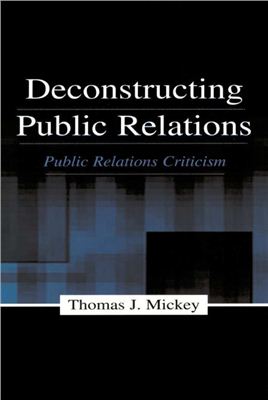Издательство Lawrence Erlbaum Associates, 2003, -176 pp.
What I try to do in this book is to show how public relations belongs to the everyday process of social construction. With all its material, public relations practice is basically a cultural product. Therefore, I believe that anyone interested in public relations should not be afraid to deconstruct public relations by challenging its assumed autonomy as a privileged mode of representation.
I have been writing about public relations as a cultural artifact for the past 10 years. This book contains much of that work, always pursuing a critical view of the field.
For my own inspiration for this book, I am grateful to a wonderful essay by J. B. Harley (1991) on deconstruction. I paraphrase his view here; where he originally talked about making maps, I substitute public relations as the practice. The interpretive act of deconstructing public relations can serve three functions. First, it allows us to challenge the epistemological myth of the cumulative progress of what many call an objective science. Second, the deconstructionist argument allows us to redefine the social importance of public relations. Third, a deconstructive tu of mind may allow public relations to take a fuller place in the interdisciplinary study of text and knowledge.
Preface vii
Why Deconstruct?
Cultural Studies Approach
Alcohol as Medicine
Representation of Woman
Selling the Inteet
Garden According to Martha Stewart
A Community Relations Campaign
The Language of Mental Illness
The Ideology of an AIDS Prevention Campaign
The Monet Exhibit
Olympic Gold
What I try to do in this book is to show how public relations belongs to the everyday process of social construction. With all its material, public relations practice is basically a cultural product. Therefore, I believe that anyone interested in public relations should not be afraid to deconstruct public relations by challenging its assumed autonomy as a privileged mode of representation.
I have been writing about public relations as a cultural artifact for the past 10 years. This book contains much of that work, always pursuing a critical view of the field.
For my own inspiration for this book, I am grateful to a wonderful essay by J. B. Harley (1991) on deconstruction. I paraphrase his view here; where he originally talked about making maps, I substitute public relations as the practice. The interpretive act of deconstructing public relations can serve three functions. First, it allows us to challenge the epistemological myth of the cumulative progress of what many call an objective science. Second, the deconstructionist argument allows us to redefine the social importance of public relations. Third, a deconstructive tu of mind may allow public relations to take a fuller place in the interdisciplinary study of text and knowledge.
Preface vii
Why Deconstruct?
Cultural Studies Approach
Alcohol as Medicine
Representation of Woman
Selling the Inteet
Garden According to Martha Stewart
A Community Relations Campaign
The Language of Mental Illness
The Ideology of an AIDS Prevention Campaign
The Monet Exhibit
Olympic Gold

